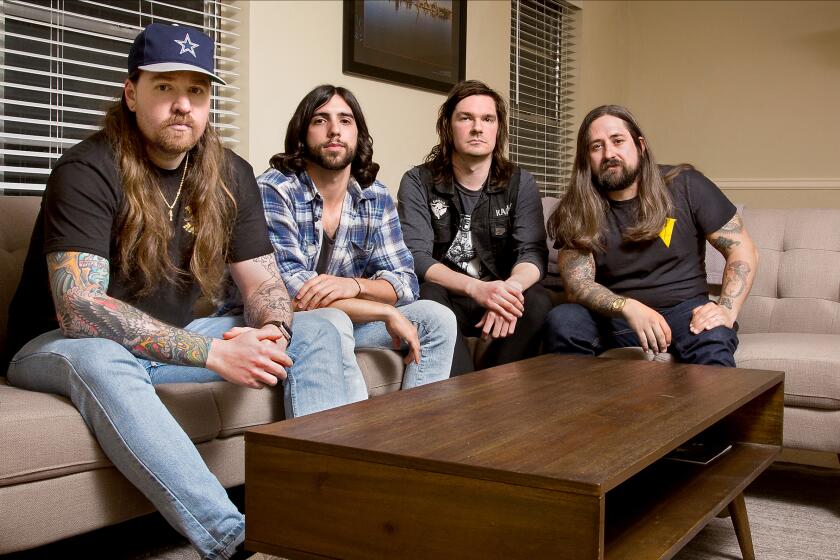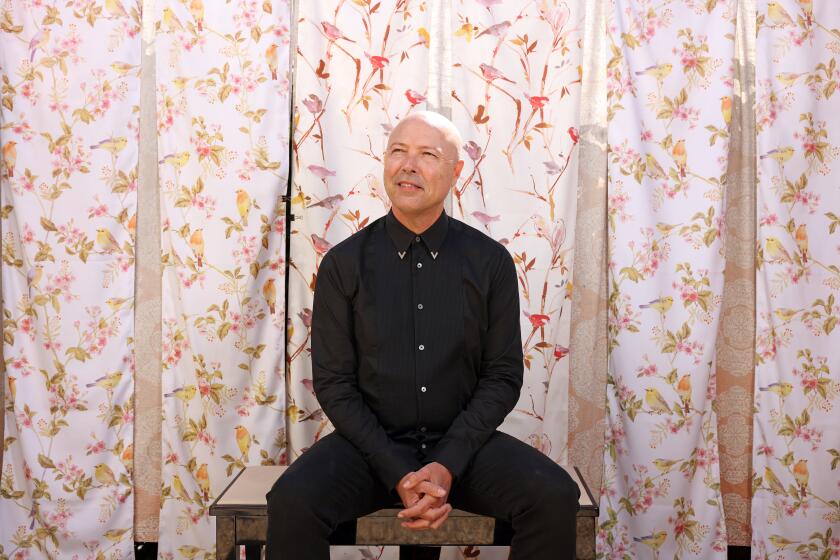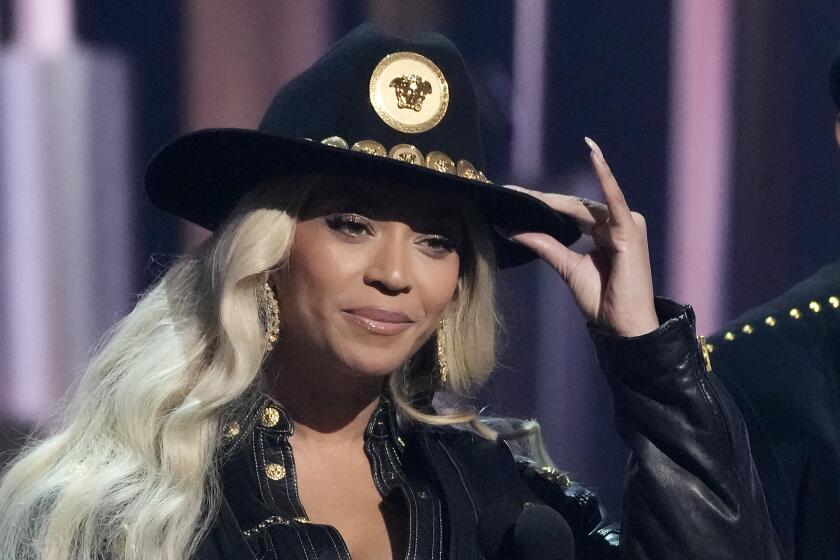How NPR’s Tiny Desk Concert became a golden ticket to the Grammys
In the spring of 2008, NPR producer Bob Boilen posted a YouTube video of a modest live performance shot at his cluttered desk at NPR’s Washington, D.C., headquarters. The set, by a little-known Northwest singer and songwriter named Laura Gibson, was recorded with a single microphone to an audience of NPR staffers.
Titling it a “Tiny Desk Concert,” Boilen didn’t expect much.
“Maybe it’s the start of something, maybe it’s not,” he casually said by way of introduction to the camera and his co-workers in the video.
Our experts forecast wins for Beyoncé’s ‘Black Parade’ and Taylor Swift’s ‘Folklore,’ and that the odds may be stacked against Megan Thee Stallion.
A dozen years and hundreds of episodes later, Tiny Desk Concert has become an essential portal: a coveted platform for artists gunning for a career in music and a creative playground for those who already have one. Last year the series generated nearly 500 million YouTube views.
Apparently, those eyeballs included a lot of Grammy voters. A staggering number of this year’s most high-profile nominees, including Taylor Swift, Megan Thee Stallion, Jacob Collier, Dua Lipa, Chika, Billie Eilish, Haim, BTS, Black Pumas, D Smoke, Jhené Aiko, Brittany Howard, Harry Styles and Phoebe Bridgers, have recently done Tiny Desk concerts despite a pandemic that’s forced artists to shift to Tiny Desk (Home) shows.

“Back in 2019 when my first Tiny Desk launched, that new audience was game-changing for me,” says multi-instrumentalist Collier via email. “I don’t think any online platform exists that does what Tiny Desk does for artists. It pulls back the curtain and challenges musicians to create something that connects without any bells and whistles.” This year Collier is nominated for three Grammys, including album of the year for “Djesse Vol. 3.”
During her 2019 set, nominee Swift called the series “one of my favorite corners of the internet,” describing it as “an opportunity for artists to decide a different way to showcase their music.” She added, “It’s just me. There’s no dancers, unfortunately.”
Boilen, 67, thinks there’s a simple reason that the series resonates, and he learned it after posting that first Laura Gibson concert to YouTube. “Something was clicking with a lot of people, and it occurred to me what it was: the intimacy.”
In their first interview since the death of their singer, Riley Gale, the surviving members of Power Trip discuss their Grammy nomination and what lies ahead.
Boilen, who also co-hosts the outlet’s enduring “All Songs Considered” podcast, said that before Tiny Desk’s launch when he would produce recorded music sessions for NPR, artists would “all be wearing headphones and pop filters in front of their faces. I wanted something that was just a person in a room.” He thought music lovers might be drawn to what he calls “the feeling we seem to have lost touch with through production and reverb — all those different things we put on as a filter.”
That distinction separates Tiny Desk Concert from the late-night network talk shows that, historically, have served as prime promotional vehicles for rising artists. The shows hosted by Stephen Colbert, Jimmy Kimmel and Jimmy Fallon might initially reach larger audiences, but with their big stages, professional lighting and amplification, feel more like concerts than Tiny Desk’s coffeehouse vibe. On “The Tonight Show Starring Jimmy Fallon,” the host and house band the Roots have even borrowed from Tiny Desk’s minimalist approach with their ongoing segment “Classroom Instruments.”

Phoebe Bridgers performing on NPR’s Tiny Desk Concerts series.
A typical Tiny Desk set features a few songs and runs under 20 minutes. The artist might pause for a brief interview with Boilen.
Bridgers, who is nominated for four Grammys — best new artist, rock performance, rock song and alternative album — calls Tiny Desk appearances “scarier than late night. It’s the middle of the day. All there is is your performance.”
That sense of danger and the format makes the effort worth it, Bridgers stresses. “The three songs really make it clear what your choices are about your record — whether it’s what you think will translate well into an acoustic setting or what you think represents your best work.”
It also rewards musicianship. Contemporary studio recordings are often puzzled together from dozens of takes. The series, by contrast, is a tight-rope walk. Mistakes stay in. The Recording Academy voters, large blocks of which are musicians and musician-minded producers and engineers, value this sort of challenge. Tiny Desk celebrates skill. One look at New Orleans band Tank and the Bangas’ career-making star-turn on Tiny Desk is proof. The popular performance, which came after the band won the third “Tiny Desk Contest” in 2017, helped land them a label deal and, not long after, a best new artist Grammy nod.
In one sense, Tiny Desk Concerts recalls another watershed series: MTV Unplugged. The series, which in its original form aired for more than a decade starting in 1989, began as a way for lesser-known rock bands to showcase their chops on acoustic instruments. Within a few years, it was featuring marquee names such as Nirvana, Paul McCartney, Mariah Carey and Eric Clapton. Airing a rap-focused set featuring De La Soul, A Tribe Called Quest and most famously LL Cool J at the end of the second season in 1991, it upended the notion for many mainstream viewers that rap artistry and live instrumentation were mutually exclusive expressions.
“Tiny Desk really is the truest form of what you sound like, whether you like it or not,” says Bridgers. “When I like a new band, I always watch their Tiny Desk. It’s a great representation of what someone sounds like.”
More often than not, those first few years of the series presented the kind of music built on guitar, piano, violin, brass instrument or some combination. Early breakouts included sets by roots bands Edward Sharpe and the Magnetic Zeros, the Avett Brothers and Swell Season and the occasional jazz or classical artist, such as bassist-composer Esperanza Spalding and cellist Yo-Yo Ma.

Notably underrepresented was contemporary Black music. But on Oct. 29, 2014, NPR Music published a Tiny Desk Concert by singer-rapper T-Pain, whose trademark use of a pitch-correcting vocal filter called Auto-Tune landed on dozens of R&B, rap and pop hits. In the video, T-Pain thanks the NPR staff for their introductory applause before confessing that “this is weird as hell for me. I’ve never done anything like this.”
After making a joke about having Auto-Tune installed inside of him, T-Pain, accompanied only by a keyboardist, proceeded to soar through a trio of R&B songs that revealed the unfiltered voice behind the pitch-shifter, which had a gloriously tuneful heft all its own.
For his millions of fans and just as many casual listeners, the desk concert was a revelation and deservedly went viral. Recalls NPR Music associate producer Bobby Carter, “That’s when we really started to open our eyes and thought about R&B and hip-hop at Tiny Desk. That put things in overdrive.”
L.A. jazz pianist and arranger John Beasley has earned four Grammy nominations, the same number as pop stars Justin Bieber, Phoebe Bridgers and Da Baby.
“For a long time,” says Carter, “it’s been a goal of NPR’s to diversify and gain traction with a diverse young audience. Tiny Desk helped bring the audience to us.” Carter adds that NPR Music’s YouTube subscriber base “is the youngest and most diverse audience that NPR has.”
Surprisingly, NPR doesn’t make any direct money from those hundreds of millions of spins, says Lauren Onkey, senior director of NPR Music. “If people are watching Tiny Desk and they see a commercial and ad, that’s because the rights holders are monetizing their rights.” She calls it “an audience driver for us. Of course, if people watch Tiny Desk videos and want to support public media — and as a result support their local public radio station or NPR — we’re thrilled.”

Chika’s Tiny Desk Concert from 2020.
Since that T-Pain booking, the series has produced many viral epiphanies. Tyler, the Creator, Alicia Keys, Jazmine Sullivan, Cat Stevens, Juanes, John Legend and Noname have all stopped by NPR headquarters. Adele’s 2011 set has over 22 million views. The late rapper Mac Miller’s magnetic performance has been viewed more than 50 million times. Anderson .Paak’s 2016 set has tallied more than 64 million views. Released while Grammy nominating committees were starting to debate who would make the cut, the set went viral. A few months later, the relatively unknown .Paak landed a best new artist nomination.
Coincidence? Perhaps, but on the road to mainstream attention, it’s become an obvious stepping stone.
Ryan Matteson, who manages artists including Japanese Breakfast, Mountain Goats and Grammy album of the year nominee Black Pumas, called the series “one of those shows where there’s only so many of those slots and it does bring an audience. So many of my clients hear from people that they discovered the artist from their Tiny Desk Concert.”
For Black Pumas’ Tiny Desk, which aired in December 2020, Matteson says his team was “constantly in conversations on our weekly calls saying, ‘This is the target. How do we get this?’ It’s super important, and it was important to the band, too.” Black Pumas, Matteson adds, had achieved some success at radio but they needed would-be fans to experience them live. “It’s a very large band that’s visually striking,” Matteson says. “To be able to have a visual component meet the radio audience on the internet was such an important goal.”
Laura Swanson, executive vice president of publicity for Warner Records, calls booking a Tiny Desk Concert “a real tentpole event that you strategize and figure out the best timing for. And then, when you get it, you jump.” Swanson says that best new artist nominee Chika, who signed to Warner in June of 2019, “absolutely credits NPR Tiny Desk and the exposure from that performance for getting her on the radar with Grammy voters.”
But for musicians, the appearance is more than an opportunity. It’s a creative challenge.
Pianist and “The Late Show with Stephen Colbert” bandleader Jon Batiste, who’s nominated for two Grammy Awards, calls a Tiny Desk concert session “the equivalent of making a live album, [and] I think that’s the beauty of those concerts. They’re not just capturing something onscreen. It feels good, but it sounds good, too. The mixing is incredible and the environment, for whatever reason, has a great natural sound.”
Batiste, whose forthcoming album, “We Are,” arrives March 19, adds that when he did his episode in 2019, his setlist consisted of songs that “were still in the process of being written. They were rough sketches. To play those songs on Tiny Desk really helped me solidify the direction I wanted to go with them.”

Tyler, the Creator’s 2017 set at NPR was such an epiphany for the rapper that after he concluded it, he cut off the applause to open up about the thinking behind the performance. Noting that he usually hated rap artists’ attempts at working with live bands because he prefers sounds such as the Roland 808 drum machine, he said that the set he and the band had just finished proved him wrong.
He complimented his players for being so open and said to the crowd, “I hope you guys enjoyed it and I’m happy you came out. Even if you’re in here and you thought, ‘That s— was trash,’ the fact that you saw me finally have the courage to be trash with a band means a lot.”
That’s one reason why Bridgers uses the series as a discovery tool, she says: “I want to see what they played on their Tiny Desk because I want to see what they like about themselves.”
More to Read
The biggest entertainment stories
Get our big stories about Hollywood, film, television, music, arts, culture and more right in your inbox as soon as they publish.
You may occasionally receive promotional content from the Los Angeles Times.













